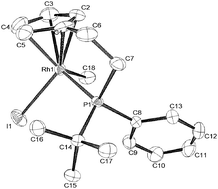The syntheses, characterization, and some reactions of (phosphanylethyl)cyclopentadienyl chelate complexes of cobalt, rhodium, iridium, nickel, and chromium with unsymmetrical substitution at the phosphorus atom are described. The ligand systems were prepared by nucleophilic ring opening of spiro[2.4]hepta-4,6-diene with lithium tert-butylphenylphosphide or lithium tert-butylcyclohexylphosphide. The anionic ligands give the respective chelate complexes by treatment with metal halide reagents. In three cases it was possible to obtain X-ray crystal structure analyses. The cobalt chelate complex undergoes oxidative addition with a dihydrosilane, the reaction results in the formation of products with three stereogenic centers at phosphorus, cobalt, and silicon, which show dynamic behavior as indicated by VTNMR. The rhodium chelate complex undergoes oxidative addition of iodomethane with diastereoselective formation of the respective Rh(III) chelate. While diastereoselectivity caused by a planar chiral indenyl ligand or by a stereogenic carbon center in the chelate backbone has earlier been observed, this is the first case of a stereoinduction by the stereogenic phosphorus ligand. Activation energies for the rotation of cobalt and rhodium chelates have also been determined by VTNMR.

You have access to this article
 Please wait while we load your content...
Something went wrong. Try again?
Please wait while we load your content...
Something went wrong. Try again?


 Please wait while we load your content...
Please wait while we load your content...